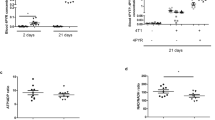Abstract
An anti-tumour agent 5,6-dimethylxanthenone-4-acetic acid (5,6-MeXAA) induced nitric oxide synthase (NOS) in the tumour, spleen, thymus and small intestine, but not in the lung, liver, kidney, heart or skeletal muscle in B6D2F1 mice bearing subcutaneous colon 38 tumours. This pattern of induction is distinct from that caused by agents such as endotoxin, muramyl dipeptide or Corynebacterium parvum. The induction of NOS (iNOS) in the tumour was more persistent (maximal at 3 days) than in other tissues (maximal at 12 h). Immunohistochemical staining suggested that iNOS was located in macrophages and endothelial cells within and around the tumour. Treatment with 5,6-MeXAA also caused substantial increases in plasma nitrite and nitrate (NOx) concentrations that peaked at 8-12 h after 5,6-MeXAA. The increase in plasma NOx was prevented by a NOS inhibitor N-iminoethyl-L-ornithine (L-NIO), indicating that it was due to enhanced production of NO. Tumour-bearing mice were more responsive than controls to 5,6-MeXAA both in their plasma NOx increase and in their lower maximally tolerated dose. L-NIO was unable to prevent the complete tumour necrosis and regression caused by 5,6-MeXAA at a dose that substantially inhibited the increase of plasma NOx. In conclusion, the experimental anti-tumour agent 5,6-MeXAA induced NO synthesis in tumour-associated macrophages and in immunologically active tissues in parallel with its effects on tumour growth. The experiments with a non-selective NOS inhibitor L-NIO, however, suggest that NO is not a significant component in the mechanism of the anti-tumour action of 5,6-MeXAA in this particular model.
This is a preview of subscription content, access via your institution
Access options
Subscribe to this journal
Receive 24 print issues and online access
$259.00 per year
only $10.79 per issue
Buy this article
- Purchase on Springer Link
- Instant access to full article PDF
Prices may be subject to local taxes which are calculated during checkout
Similar content being viewed by others
Author information
Authors and Affiliations
Rights and permissions
About this article
Cite this article
Moilanen, E., Thomsen, L., Miles, D. et al. Persistent induction of nitric oxide synthase in tumours from mice treated with the anti-tumour agent 5,6-dimethylxanthenone-4-acetic acid. Br J Cancer 77, 426–433 (1998). https://doi.org/10.1038/bjc.1998.68
Issue Date:
DOI: https://doi.org/10.1038/bjc.1998.68
This article is cited by
-
MG624, an α7-nAChR antagonist, inhibits angiogenesis via the Egr-1/FGF2 pathway
Angiogenesis (2012)
-
Vascular disrupting agent DMXAA enhances the antitumor effects generated by therapeutic HPV DNA vaccines
Journal of Biomedical Science (2011)
-
5,6-Dimethylxanthenone-4-acetic acid (DMXAA), a novel antivascular agent: phase I clinical and pharmacokinetic study
British Journal of Cancer (2003)



